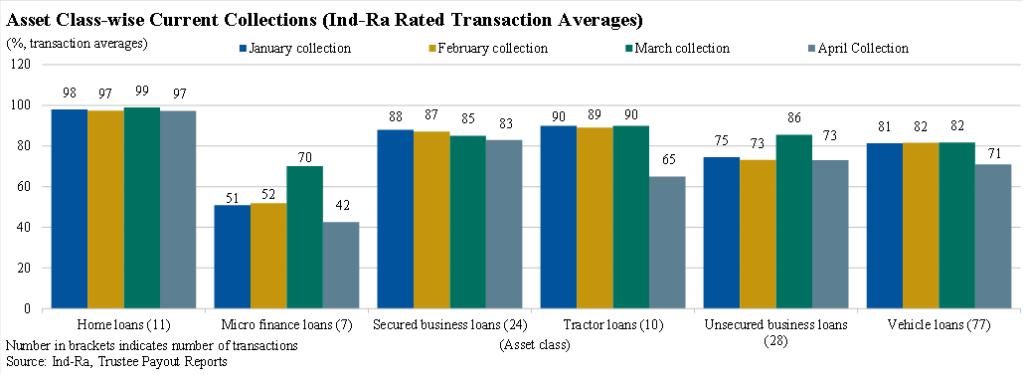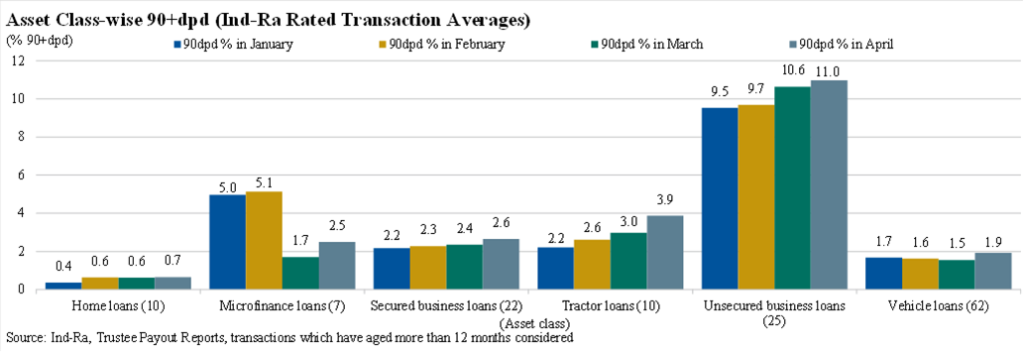India Ratings and Research (Ind-Ra) witnessed a drop in April 2021 collections (May 2021 pay-outs) in the rated securitisation transactions across asset classes.
As per early signals, the second covid wave is expected to significantly affect May 2021 loan pool collections (June 2021 payouts) due to borrowers’ stretched liquidity and lenders’ collection disruptions, Ind-Ra said.
The agency believes the second wave and its demand disruption will continue to impact borrowers at the bottom of the pyramid and transactions will witness moderately more delinquencies from rural geographies in FY22 than in FY21. Although delinquencies are expected to build up, majority of the lenders are restructuring stressed loans minimally.
The pandemic’s impact on businesses and thereby on loan performance is characterised by transient liquidity stress and structural delinquency build-up. The agency in May 2021 assessed the liquidity impact of the second wave on the rated transactions.
The agency will monitor the deterioration, if any, in loan pool delinquencies by end-2QFY22. Although most of the rated transactions have aged and credit enhancements (CE) have built-up adequately, Ind-Ra will continue evaluating if the available enhancements are adequate for the rating level stresses, given that some of the transactions have again started dipping into transaction cash collaterals. Along the way, the agency will recalibrate the base case default rate and recovery rates by reassessing the delinquency build-up in the originator’s portfolio and in rated transactions.
Dispersed Second Wave to Impact Rural Collections: The resurgence of the pandemic in April-May 2021 and the consequent containment measures affected collections in securitisation transactions across asset segments and across geographies. The impact in transaction collections in April 2021 was limited as the restrictions came into play in the second half of the month. Across all Ind-Ra rated transactions, the current collections reduced to 73% in April 2021 from 84% in March 2021.
Containment restrictions (in a staggered manner across most of the country) and consumer sentiments affected businesses in April-May 2021.
Even as non-banks ramped up digital infrastructure, collections could be impacted significantly in May 2021 (June 2021 payouts) primarily because lenders were forced to stop door-to-door collections after agents, staff and borrowers had fallen ill. In a situation where the safety of the employees is paramount, lenders are cautious regarding their staff stepping out for collections and follow-ups.
Disruptions in face-to-face collections significantly affect microfinance loan performance. A number of microfinance borrowers were paying one month’s due in January to March, but since they were already in overdue and collection allocation is first made to overdue rather than current dues, the current collections are lower.

Muted Medium-term Sentiment: The economic impact from subsequent pandemic waves could be smaller than from the first as economic agents learn to ‘operate within a pandemic’.
Although the nature of the shock in the second wave is different from the first one, Ind-Ra believes the impact of capital obsolescence that started off in FY21, due to structural changes in consumption patterns and investment priorities, will continue in FY22.
The economic agents adjusted expenditures and savings in FY21 to align with the new normal. These adjustments added to the pent-up demand in 2HFY21 and resulted in a differentiated business recovery. Thus while most businesses recovered, there are pockets of stress in each asset class, as characterised by the nature of business, such as contact-intensive discretionary services which may not recover until sizeable population is vaccinated.
The comeback of demand levels in FY22 post the second wave may not be to the levels witnessed in FY21, due to the lower consumer sentiment as a fall out of the widespread health crisis. Also, the consumption adjustments / investments to align with the new normal have already been executed by economic agents in FY21.
The second wave is more dispersed and thus smaller towns and villages witnessed a sharp rise in infections and fatality. This could affect the rural non-agri demand sentiment and rural employment levels in addition denting urban demand.
With reduced income levels and higher health expenditures, Ind-Ra expects the performance of asset segments such as microfinance to be significantly affected. Asset segments dependent on agriculture such as tractor/farm equipment loans are expected to be affected to a lower extent as they cater to the non-discretionary demand.
The pandemic shocks continue to adversely impact the low-middle-income individuals and small businesses, whose loans are typically securitised in India. The pandemic has also accelerated the formalisation of the economy where bigger/organised businesses are gaining market share from smaller businesses, Ind-Ra said.
Delinquency Build-up & Restructuring: Ind-Ra expects the impact of second wave and the uncertainty of subsequent waves to play out on the rated transaction performance in the forthcoming months as borrowers continue to skip payments.
Ind-Ra expects an additional layer of delinquency build-up in the securitisation pools over and above the delinquency currently witnessed by these pools. Vulnerable borrowers (both individuals and businesses) would have already slipped into delinquency during the first shock in FY21 and incremental delinquencies in FY22 are expected from non-urban geographies and borrowers with fragile financial cushions.

Unlike the blanket moratorium that some of the lenders dispensed for the benefit of borrowers in FY21, currently lenders have to approach each borrower and identify if the business is affected by the pandemic and possibly establish documentary evidence of the same for restructuring.
Also, borrowers’ apprehension if restructuring will put a marker on their credit reports, making it difficult for them to take incremental loans from other lenders, adds to the hesitation to restructure loans. In this context, Ind-Ra believes unlike moratorium, borrowers will insist on COVID-related restructuring only when genuinely required.
Securitisation Volumes in FY21: Indian securitisation volumes that severely dipped in 1HFY21 made a comeback in 2HFY21 as clarity emerged on collections and as investor confidence improved. Ind-Ra rated 24 securitisation transactions aggregating issuance amount of Rs 133.8 billion in 2HFY21.
These transactions (both priority sector lending and non-priority sector lending pools) securitised pools of varied asset classes such as commercial vehicle loans, tractors loans, home loans, loans against properties, two-wheeler loans, personal loans and consumer loans.
The market saw tepid volumes of securitisation of poorly performing asset classes such as microfinance loans. Given uncertainty in collections due to the second wave, securitisation volumes have moderated in 1QFY22.





